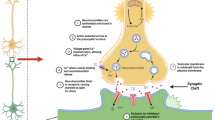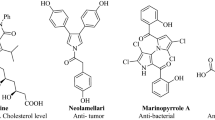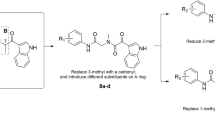Abstract
Aim:
To investigate the binding mode of synthesized adamantly derivatives inside of cholinesterase enzymes using molecular docking simulations.
Methods:
A series of hybrid compounds containing adamantane and hydrazide moieties was designed and synthesized. Their inhibitory activities against acetylcholinesterase (AChE) and (butyrylcholinesterase) BChE were assessed in vitro. The binding mode of the compounds inside cholinesterase enzymes was investigated using Surflex-Dock package of Sybyl7.3 software.
Results:
A total of 26 adamantyl derivatives were synthesized. Among them, adamantane-1-carboxylic acid hydrazide had an almost equal inhibitory activity towards both enzymes, whereas 10 other compounds exhibited moderate inhibitory activity against BChE. The molecular docking studies demonstrated that hydrophobic interactions between the compounds and their surrounding residues in the active site played predominant roles, while hydrophilic interactions were also found. When the compounds were docked inside each enzyme, they exhibited stronger interactions with BChE over AChE, possibly due to the larger active site of BChE. The binding affinities of the compounds for BChE and AChE estimated were in agreement with the experimental data.
Conclusion:
The new adamantly derivatives selectively inhibit BChE with respect to AChE, thus making them good candidates for testing the hypothesis that BChE inhibitors would be more efficient and better tolerated than AChE inhibitors in the treatment of Alzheimer's disease.
Similar content being viewed by others
Log in or create a free account to read this content
Gain free access to this article, as well as selected content from this journal and more on nature.com
or
References
Majnaric-Trtica L . Update on biological, social and economical aspect of Alzheimer's disease and other dementia. Period Biol 2009; 111: 381–8.
Laursen B, Mork A, Plath N, Kristiansen U, Bastlund JF . Impaired hippocampal acetylcholine release parallels spatial memory deficits in Tg2576 mice subjected to basal forebrain cholinergic degeneration. Brain Res 2014; 1543: 253–62.
Greig NH, Utsuki T, Yu Q, Zhu X, Holloway HW, Perry T, et al. A new therapeutic target in Alzheimer's disease treatment: attention to butyrylcholinesterase. Curr Med Res Opin 2001; 17: 159–65.
Loizzo MR, Tundis R, Menichini F, Menichini F . Natural products and their derivatives as cholinesterase inhibitors in the treatment of neurodegenerative disorders: an update. Curr Med Chem 2008; 15: 1209–28.
Sener B, Orhan I . Exploring Turkish biodiversity: A rich source of chemical diversity for drug leads discovery. Pure Appl Chem 2011; 83: 1699–707.
Lekishvili N, Lekashvili O, Zurabishvili D, Fachulia Z, Giorgadze K . Synthesis and study of new adamantane-containing hydrazide-hydrazone ligands and coordination compounds based on them. Oxid Commun 2012; 35: 457–75.
El-Emam AA, Alrashood KA, Al-Omar MA, Al-Tamimi AS . Synthesis and antimicrobial activity of N′-heteroarylidene-1-adamantylcarbohydrazides and (±)-2-(1-adamantyl)-4-acetyl-5-5-(4-substituted phenyl-3-isoxazolyl)-1,3,4-oxadiazolines. Molecules 2012; 17: 3475–83.
Hassan GS, El-Emam AA, Gad LM, Barghash AM . Synthesis, antimicrobial and antiviral testing of some new 1-adamantyl analogues. Saudi Pharm J 2010; 18: 123–8.
Kadi AA, El-Brollosy NR, Al-Deeb OA, Habib EE, Ibrahim TM, El-Emam AA . Synthesis, antimicrobial, and anti-inflammatory activities of novel 2-(1-adamantyl)-5-substituted-1,3,4-oxadiazoles and 2-(1-adamantylamino)-5-substituted-1,3,4-thiadiazoles. Eur J Med Chem 2007; 42: 235–42.
Makovec F, Artusi R, Zanzola S, Rovati LC . Adamantane derivatives with neuroprotective, antidepressant and anti-ischaemic activities. U S Pat 2006; 7145037 B2.
Yeh VSC, Patel JR, Yong H, Kurukulasuriya R, Fung S, Monzon K, et al. Synthesis and biological evaluation of heterocycle containing adamantane 11β-HSD1 inhibitors. Bioorg Med Chem Lett 2006; 16: 5414–19.
Chohan ZH, Pervez H, Khan KM, Supuran CT . Organometallic-based antibacterial and antifungal compounds: transition metal complexes of 1,1′-diacetylferrocene-derived thiocarbohydrazone, carbohydrazone, thiosemicarbazone and semicarbazone. J Enzyme Inhib Med Chem 2005; 20: 81–9.
Rollas S, Gulerman N, Erdeniz H . Synthesis and antimicrobial activity of some new hydrazones of 4-fluorobenzoic acid hydrazide and 3-acetyl-2,5-disubstituted-1,3,4-oxadiazolines. Farmaco 2002; 57: 171–4.
Bedia KK, Elcin O, Seda U, Fatma K, Nathaly S, Sevim R, et al. Synthesis and characterization of novel hydrazide-hydrazones and the study of their structure-antituberculosis activity. Eur J Med Chem 2006; 41: 1253–61.
Rasras AJ, Al-Tel TH, Al-Aboudi A, Al-Qawasmeh RA . Synthesis and antimicrobial activity of cholic acid hydrazone analogues. Eur J Med Chem 2010; 45: 2307–13.
Al-Aboudi A, Odeh H, Khalid A, Naz Q, Choudhary MI . Butyrylcholinesterase inhibitory activity of testosterone and some of its metabolites. J Enzyme Inhib Med Chem 2009; 24: 553–8.
Huang N, Shoichet BK, Irwin JJ . Benchmarking sets for molecular docking. J Med chem 2006; 49: 6789–801.
Erickson J A, Jalaie M, Robertson DH, Lewis RA, Vieth M . Lessons in molecular recognition: the effects of ligand and protein flexibility on molecular docking accuracy. J Med Chem 2004; 47: 45–55.
Clark M, Meshkat S, Talbot GT, Carnevali P, Wiseman JS . Fragment-based computation of binding free energies by systematic sampling. J Chem Inf Model 2009; 49: 1901–13.
Jain AN . Bias, reporting, and sharing: computational evaluations of docking methods. J Comput Aided Mol Des 2008; 22: 201–12.
Kellenberger E, Rodrigo J, Muller P, Rognan D . Comparative evaluation of eight docking tools for docking and virtual screening accuracy. Proteins 2004; 57: 225–42.
Chiou SY, Huang CF, Hwang MT, Lin G . Comparison of active sites of butyrylcholinesterase and acetylcholinesterase based on inhibition by geometric isomers of benzene-di-N-substituted carbamates. J Biochem Mol Toxicol 2009; 23: 303–8.
Sekutor M, Mlinaric-Majerski K, Hrenar T, Tomic S, Primozic I . Adamantane-substituted guanylhydrazones: novel inhibitors of butyrylcholinesterase. Bioorg Chem 2012; 41–42: 28–34.
Ellman GL, Courtney KD, Featherstone RM . A new and rapid colorimetric determination of acetylcholinesterase activity. Biochem Pharmacol 1961; 7: 88–95.
Spitzer R, Jain AN . Surflex-Dock: Docking benchmarks and real-world application. J Comput Aided Mol Des 2012; 26: 687–99.
Jain AN . Surflex-Dock 2.1: robust performance from ligand energetic modeling, ring flexibility, and knowledge-based search. J Comput Aided Mol Des 2007; 21: 281–306.
Miteva MA, Lee WH, Montes MO, Villoutreix BO . Fast structure-based virtual ligand screening combining FRED, DOCK, and Surflex. J Med Chem 2005; 48: 6012–22.
Jain AN . Surflex: fully automatic flexible molecular docking using a molecular similarity-based search engine. J Med Chem 2003; 46: 499–511.
Pacchioni G, Clotet A, Marchand AP, Dongxia X, Bott SG . Synthesis of (Z)- and (E)-1,2-di(1-adamantyl)ethene and their respective reactions with dichlorocarbene. Tetrahedron 1996; 52: 825–32.
Bormasheva KM, Nechaeva ON, Moiseev IK . Reactions of adamantyl-substituted keto esters with hydrazine and phenylhydrazine. Russ J Org Chem 2008; 44: 1760–4.
Al-Omar MA, Al-Abdullah ES, Shehata IA, Habib EE, Ibrahim TM, El-Emam AA . Synthesis, antimicrobial, and anti-inflammatory activities of novel 5-(1-adamantyl)-4-arylideneamino-3-mercapto-1,2,4-triazoles and related derivatives. Molecules 2010; 15: 2526–50.
Nicolet Y, Lockridge O, Masson P, Fontecilla-Camps JC, Nachon F . Crystal structure of human butyrylcholinesterase and of its complexes with substrate and products. J Biol Chem 2003; 278: 41141–7.
Arendt T, Brückner MK, Lange M, Bigl V . Changes in acetylcholinesterase and butyrylcholinesterase in Alzheimer's disease resemble embryonic development — a study of molecular forms. Neurochem Int 1992; 21: 381–96.
Kamal MA, Qu X, Yu QS, Tweedie D, Holloway HW, Li Y, et al. Tetrahydrofurobenzofuran cymserine, a potent butyrylcholinesterase inhibitor and experimental Alzheimer drug candidate, enzyme kinetic analysis. J Neural Transm 2008; 115: 889–98.
Acknowledgements
The authors are grateful to the Deanship of Graduate Studies at the University of Jordan for financial support. Co-author (Zaheer UL-HAQ) is thankful to the Pakistan Science Foundation (PSF) for their financial support of computational studies.
Author information
Authors and Affiliations
Corresponding authors
Rights and permissions
About this article
Cite this article
Al-Aboudi, A., Al-Qawasmeh, R., Shahwan, A. et al. In-silico identification of the binding mode of synthesized adamantyl derivatives inside cholinesterase enzymes. Acta Pharmacol Sin 36, 879–886 (2015). https://doi.org/10.1038/aps.2014.173
Received:
Accepted:
Published:
Issue date:
DOI: https://doi.org/10.1038/aps.2014.173



